
Co-ops focus on the uninsured to secure their niche as a payer
Early response bodes well for new plans
CO-OP leaders across the country know they don’t have the manpower or brand recognition of large commercial insurers, but they believe they will be able to carve out a niche in the evolving healthcare landscape. They’ll begin by targeting the uninsured, focusing on creating member-centered systems and policies, and adopting care management practices that don’t rely on fee-for-service payment structures.
“We do not think that we’re going to slip a lot of insured people into our plan,” says Peter Beilenson, MD, chief executive officer of Evergreen Health Cooperative in Maryland. “We would love if that was the case. We are trying not to be naïve.”
Dr. Beilenson says the Consumer Operated and Oriented Plan will target the approximately 420,000 in the state who are uninsured and not eligible for Medicaid and says it will need approximately 15,000 to 20,000 covered lives in the first year to be sustainable.
“The uninsured folks-who hopefully we will have reached with our marketing strategy-they are much less likely to have brand loyalty. Many of them have been uninsured for a long period of time. They don’t trust the healthcare system as much, so they don’t tend to necessarily go with the big insurers,” he says.
CO-OP ON TARGET
Evergreen Health Cooperative is one of 24 CO-OPs that were able to secure federal loans before the fiscal cliff deal abruptly shut down the loan program earlier this year. CO-OP executives who managed to secure the loans before the funding halted say they are poised and ready to open enrollment on the insurance exchanges.
“We have filed our rates and forms and expect to be on the exchange on October 1 when enrollment starts and start services January 1,” says Dr. Beilenson. “We’re right on target.”
Executives are uncertain how their premiums will compare to other commercial plans since the deadlines in many states for submitting proposed plans has not occurred and rates are unknown, but they say they believe their premium rates will likely be on the lower end of plans offered on the exchanges.
Dr. Beilenson also says the organization believes it will be cost competitive in its preferred provider organization (PPO) because of a leaner staff and lower administrative costs.
Evergreen Health Cooperative will also offer an exclusive provider organization (EPO), which he says will be a closed panel system based on the primary care medical home model, payment reform and evidence-based practices that are tied together with technology. With the EPO, he says the most significant cost savings will likely be derived from reductions to hospitalizations and emergency room visits.
PRICE DRIVES CHOICE
Martin Hickey, MD, chief executive officer of New Mexico Health Connections, says ultimately price will drive consumer choice.
“A lot of us are getting pretty good rates particularly when compared to usual commercial rates. The problem facing the other carriers is cannibalizing their own commercial business,” he says.
While Dr. Hickey says the cooperative will need to create some margin to repay loans, he says the plan will pass a portion of savings onto providers, particularly for good health outcomes.
“Our goal is to do shared savings programs in particular with primary care high quality specialists and highly functional hospitals who not only have a track record of safety but also are outstanding in transitions of care and so forth,” he says. “Since we have no external stakeholder, we don’t have to pay a share holder, we don’t have to meet the requirements of the mutual company and we are the only not-for-profit plan, so that gives us some leeway.”
NURSE COORDINATORS
Bobbette Bond, project officer for the Nevada Health CO-OP, says members of the cooperative’s formation board plan to draw from their previous success with the Culinary Health Fund, a self-funded plan for hospitality workers that has operated for decades in Las Vegas and covers about 120,000 lives. While the Culinary Health Fund continues to run, many of the members on the cooperative’s formation board have held leadership roles in the health fund and plan to adopt similar methods and approaches to care.
For instance, the Culinary Health Fund runs a health advocate program where nurses go directly into hospitals to visit members to improve discharge planning, nurse engagement and member navigation.
“We’ve found that that really saves money,” Bond says. “When you take really good care of members, you save money by trying to anticipate their healthcare needs and preventing them from getting worse. That has actually worked a lot for us in terms of our healthcare trend, so that’s our version of managed care.”
The Nevada Health CO-OP also hopes to benefit from the Culinary Health Fund’s established relationship in the Latino community. Since about 40% of the health fund’s members are bilingual, they have experience engaging and navigating the Spanish speaking community.
“We were the first plan that I know of in the country to create a bilingual explanation of benefits,” Bond says of the Culinary Health Fund, adding that the cooperative hopes to attract members who are already familiar with the Culinary Health Fund and either no longer have access to the plan serving hospitality workers or have heard about the plan through friends and family.
In addition to adopting similar programs and outreach efforts, the cooperative will also use the Culinary Health Fund’s provider network to provide care in the southern region of the state and are working to create a new provider network in the northern area of the state.
As CO-OPs establish provider networks, they say provider interest has been positive.
“The bottom line is we come with payment for patients that previously were not paid for,” Dr. Beilenson says.
CO-OPs won’t know the community’s true interest or investment in the community-run healthcare option until October when enrollment opens, but Bond says early indications are promising. The Nevada Health CO-OP has created a reservation system that allows potential members to reserve a spot in the plan early.
“When they come back in the fall we can work with them directly in a more expedited way to get them enrolled and we are really excited about the early response we’re having to that,” she says.
Leaders are in the process of constructing custom claims and enrollment systems, but New Mexico Health Connections and Evergreen Health Cooperative say they will turn to third parties for claims processing.
“Our goal is obviously if we are successful as a co-op, which we think we will be, we would certainly eventually bring it in house probably in the near future but not in the first year,” Dr. Beilenson says.
The Evergreen Health Cooperative, which is being led by a formation board that is a mix of insurance executives and former public health officials, is also using a third party administrator to handle enrollment.
While the cooperative’s primary demographic target is working class individuals who may have struggled in the past to afford healthcare, Dr. Beilenson says, the EPO’s smaller patient panels, care coordinator and personal health coaches in every primary care center could attract a larger demographic as well.
“We think we’ll actually be of interest to people, professionals and others, who believe in a co-op,” he says.
The plan’s PPO will be a robust network throughout Maryland, but the EPO will begin with a smaller footprint. Initially, the EPO will begin with four primary care centers along the corridor between Baltimore and Washington D.C., with the intent to expand over time.
RATIONAL HEALTHCARE
Dr. Hickey says the most significant hurdles for CO-OPs will be the lack of an established brand and initially generating and sustaining enrollment. Despite these challenges, he believes CO-OPs will secure their place in the industry.
“Our orientation toward care and toward the market will give us an excellent chance to grow and be a strong factor in getting healthcare delivered and be rational instead of this volume-based fee-for-service craziness that we totally wrapped ourselves into,” Dr. Hickey says.
Newsletter
Get the latest industry news, event updates, and more from Managed healthcare Executive.




